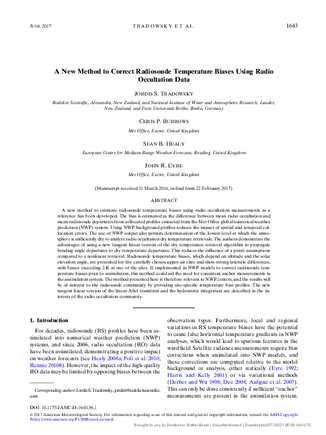
GCOS Reference Upper-Air Network
Title
A New Method to Correct Radiosonde Temperature Biases Using Radio Occultation Data
Authors
Tradowsky, J. S., Burrows, C. P., Healy, S. B., & Eyre, J. R.
Published
by Journal of Applied Meteorology and Climatology (JAMC) at 2017-02-22
Abstract
A new method to estimate radiosonde temperature biases using radio occultation measurements as a reference has been developed. The bias is estimated as the difference between mean radio occultation and mean radiosonde departures from collocated profiles extracted from the Met Office global numerical weather prediction (NWP) system. Using NWP background profiles reduces the impact of spatial and temporal collocation errors. The use of NWP output also permits determination of the lowest level at which the atmosphere is sufficiently dry to analyze radio occultation dry temperature retrievals. The authors demonstrate the advantages of using a new tangent linear version of the dry temperature retrieval algorithm to propagate bending angle departures to dry temperature departures. This reduces the influence of a priori assumptions compared to a nonlinear retrieval. Radiosonde temperature biases, which depend on altitude and the solar elevation angle, are presented for five carefully chosen upper-air sites and show strong intersite differences, with biases exceeding 2 K at one of the sites. If implemented in NWP models to correct radiosonde temperature biases prior to assimilation, this method could aid the need for consistent anchor measurements in the assimilation system. The method presented here is therefore relevant to NWP centers, and the results will be of interest to the radiosonde community by providing site-specific temperature bias profiles. The new tangent linear version of the linear Abel transform and the hydrostatic integration are described in the interests of the radio occultation community.
Citation
Tradowsky, J. S., Burrows, C. P., Healy, S. B., & Eyre, J. R. (2017). A New Method to Correct Radiosonde Temperature Biases Using Radio Occultation Data, Journal of Applied Meteorology and Climatology, 56(6), 1643-1661. https://doi.org/10.1175/JAMC-D-16-0136.1
